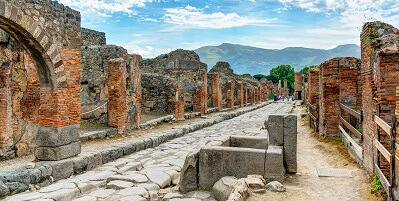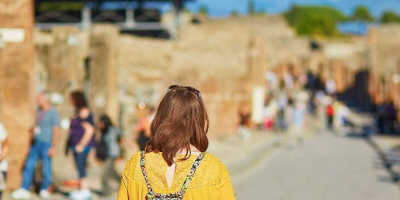What did the people of Pompeii look like?
We are all familiar with the cast bodies of mount Vesuvius’s victims but have you ever wondered what the people of Pompeii may have looked like? What they wore?
Although we know a lot about the ancient people of Pompeii, their looks still are a bit of a mystery. By discovering more and more artefacts within the lost city, we have gotten a better understanding of these late people and how they would have looked like before their demise.
What happened to the People in Pompeii?
The Pompeii people have gone down in history for their tragic deaths from the nearby volcano, Mount Vesuvius. Despite the many catastrophic waves of the volcano, including earthquakes, tsunami, and of course volcano, the rain of ash was the citizen’s demise. The scorching smoke rained down on the city, with the ‘pyroclastic flows’ containing gas, ash and rock. Essentially, the gas was so hot and toxic, it essentially burned people alive. The waves reached speeds of 700km per hour, so even those who ran were no match. Tragically anyone who hadn’t left days prior to the eruption did perish along with the city.
-
Their features
Typical features of Pompeii people were of the Mediterranean complexion, with tanned skin, dark eyes, and even darker hair. However, around 30% of the entire population of Pompeii were slaves, who varied in complexion due as they were thought to be from a wide range of countries. Their origin range from Greek, African, Celtic, and more.
-
Their physiques
By studying the remaining bones of Pompeii, archaeologists have estimated that the average height for men was 1.67metrres and 1.54metres for women, which is actually quite similar to nearby cities nowadays. Their teeth were said to be very healthy for ancient times, which strongly due to their diet. As the area had rich volcanic soil nearby, crops were aplenty, ensuring the city always had plenty of fresh fruit, grains, and had water with high levels of fluorine. However, even despite their strong teeth, there is evidence that a large portion of the Pompeii people was overweight. With 10% of the population obese and quite hairy. The disease was common throughout the city, as the ancient people were unaware of common illnesses. Some main diseases found in multiple citizens were Diabetes and a hormonal disorder, named Hyperostosis Frontalis Interna.
-
Their Beauty Standards
When Pompeii first began, the beauty standards were similar to the Pompeii people’s natural features. Dark hair, eye, and golden dark skin was all the rage, with most using oils and creams to make their hair and skin glisten and glow. However, once foreign slaves were brought to the city, and the northern women’s pale skin and blonde hair started to interest the Pompeii men. Soon the roman women began to copy this look. Creating a completely new beauty standard of soft fair skin, white faces, bright red lips, and blonde hair. Even as this style changed for women, the beauty standard for men still remained tanned and muscular. Majority of the frescos remaining depict women with fair skin, looking delicate and soft compared to their strong male counterparts.
-
Their clothing
Credit: Corbis – Getty
What the people wore within the city depended on their gender, class, and wealth. Men wore knee-length tunics with a belt, otherwise, they would wear a beige or white toga which wrapped around the body. Women preferred colourful attire, wearing either shift with a simple tunic, or instead of a stole that fell to the ankles. They usually wore the fabric wrapped around them, so as the material would not fall off when walking. Before a woman was married, they would have to wear all white, to show they pure integrity. Most of the fabric used was wool or linen. Salves wore simple and dark togas, sometimes even wearing hats.
-
Their jewellery
Jewellery was a typical item for citizens, being a status item to display your wealth to others. However, unlike today, it was mostly worn by men, except for the rare wealthy women. All of it was gold items, with gemstones and pearls used on occasions. No slaves would ever wear jewellery except when it is given as a gift to them by their masters. With a couple examples of slave girls wearing snake bracelets with the words; “Dominus ancillae sure” which translates to the master to his slave girl.
-
Their makeup
As a pale complexion was not the natural tone for the Pompeii people, women would use white foundations and powders made from lead or powdered chalk and animal fat to layer their face and neck in white. Their bright lipstick was used with ochre or molluscs, and their eyeliner from mere soot. They made their skin like silk to touch by soaking in milk to prevent wrinkles and layering their bodies with oil-based scents to captivate others around them. They did this so much it is even thought that they bathed in perfumes, washing their hair with certain scents. These scents were made from spices and herbs, including lavender, cardamom, saffron, rose, and orange. When not bathing in these scents, they would store them in small, tightly-stoppered glass bottles, much like we do today.
To achieve the light hair, a lot of women either bleached their hair or wore blonde wigs. These wigs were made from foreign salve girl’s hair and were ridiculously expensive. Hairstyles once were simple buns or plaits tied back from the woman’s face. However, as the city’s prosperity and style increased, their hairstyles became so grand that it took numerous slaves to work at once to keep the hair in place.
Related article: What Crops Did They Grow in Pompeii?
















